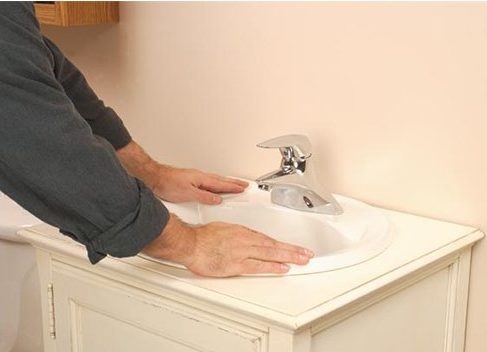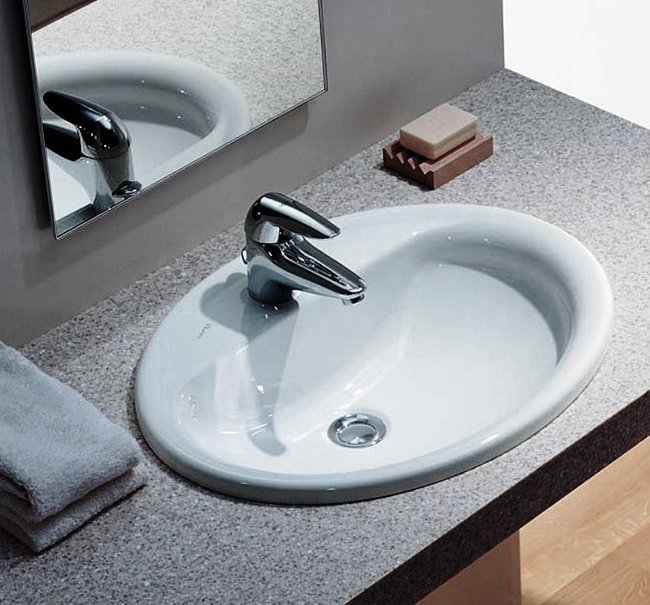How to eliminate odor from the kitchen sink?
The kitchen is a place where delicious and appetizing aromas reign. But sometimes extremely unpleasant odors from the sewer can arise in the room. What to do? Read on to learn about the sources of the problem, the degree of its danger, how to detect and eliminate the flaw, as well as preventive measures.
The content of the article
Causes of unpleasant odor from the sink
Let's consider the situations in which this malfunction occurs:
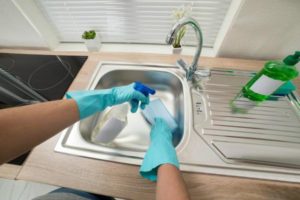 The most common option is blockage in siphon, because during its service life the device is gradually filled with various kinds of food and fatty residues. The waste should go down the drain, but the particles get stuck and then deposit on the walls, forming an increasing layer over time.
The most common option is blockage in siphon, because during its service life the device is gradually filled with various kinds of food and fatty residues. The waste should go down the drain, but the particles get stuck and then deposit on the walls, forming an increasing layer over time.- Often, plumbing malfunctions are caused by clogged sewer pipe.
- The following defect appears if the owner has long doesn't use the washbasin. As a result, the waste disposal system is not filled with liquid, which simply evaporates. The design of the siphon may be different, but the principle of operation remains the same: there is a water plug inside that blocks the penetration of various gases from the sewer pipe.
- Siphon mechanism compiled with errors. Its installation scheme is simple, because it consists of a ready-made set of parts that only need to be correctly connected to each other. Any mistake or inattention will lead to the water seal not working.
- Corrugated pipe connected to riser leaky. This happens if the diameter of the pipe is larger or smaller than the diameter of the corrugation and there is no gasket between them.
- Sagging corrugated tube. Over time, the element can stretch or sag, resulting in the draining process being disrupted. The drain begins to stagnate in the sagging area or drains entirely, and a water seal does not form.
- Damage to siphon parts. After prolonged use or as a result of external influences (accidental impacts, other damage), plastic can lose elasticity and become cracked. The pipes begin to leak liquid coming from the drain. The water evaporates or permeates the walls and floor, but its smell remains.
- Air lock in the riser may lead to malfunction.
Is it dangerous?
Sewage gases pose a certain threat to humans. There are three main types of gas mixtures formed based on hydrogen sulfide, ammonia and methane. Hydrogen sulfide and ammonia compounds are accompanied by a specific odor, methane compounds do not smell. Their prolonged concentration indoors leads to a deterioration in health:
- damage to the respiratory tract (bronchi, lungs);
- partial loss of smell;
- effects on the nervous system (anxiety, breakdowns, fainting).
Diagnostics
To identify the specific cause of the malfunction, let's perform a few simple tests:
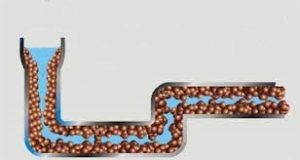 Let's see how quickly water is removed from the sink.If slow drainage or no drainage is detected, then we are dealing with a blockage.
Let's see how quickly water is removed from the sink.If slow drainage or no drainage is detected, then we are dealing with a blockage.- Let's inspect the sewer pipe, but inspection will only help when the dirt is concentrated at the very top.
- Let's pay attention to the appearance of the siphon structure: tightness of the connections, condition of the corrugation (normal shape, no cracks), absence of any damage to the elements. Defects found will indicate wear of equipment, seals, or improper assembly. Place the corrugated tube in the container and turn on the water. If there are no violations with the drain, move on to the next point.
- An air lock in the system can be detected by slow drainage and a characteristic sound (gurgling).
Reference! In serious cases, call a plumber, but in most situations the defects can be repaired on your own.
How to get rid of the problem?
A clogged siphon can be easily cleaned of deposits. We use the simplest and most accessible tool that is convenient to work with.
plunger
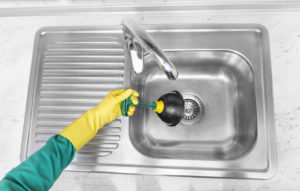 The device is pressed against the sink drain, then warm water is released under pressure. When the liquid reaches the upper edge of the rubber cap, press the handle with force, making up and down movements. After destroying the plug, remove the valve and wash the remaining waste.
The device is pressed against the sink drain, then warm water is released under pressure. When the liquid reaches the upper edge of the rubber cap, press the handle with force, making up and down movements. After destroying the plug, remove the valve and wash the remaining waste.
On a note! Simple stains can be removed with improvised objects when you don’t have a plunger at hand. For example, a corner is cut off on a milk carton and the drain is covered with this part, and then a few sharp pushes are made.
By cable
You can remove a clogged sewer pipe on your own if it is located at a close distance (up to 6 meters). Used for work a plumbing cable equipped with a handle at one end and a brush or hook at the other.
We follow the procedure: hold the handle firmly in your hand and begin to slowly rotate the device until it is able to move deeper into the pipe. When the device hits a blockage, we break it up and push the dirt further or remove it, depending on the type of part at the end of the cable.
Important! At the end of the process, the tool should be washed, dried and lubricated with machine oil.
Water pressure
If the sink has not been used for a long time, it will be enough to turn on the water at medium pressure so that the siphon device is filled with liquid. Then you need to wait until the bad odors stop appearing.
Install the siphon correctly
An incorrectly assembled device should be dismantled and the parts connected in the correct sequence (according to the instructions).
Check sealing
 Question about sealing The solution between the sewer pipe and the corrugated pipe is easy: just install a seal of suitable diameter, it will close the free space through which gases penetrate.
Question about sealing The solution between the sewer pipe and the corrugated pipe is easy: just install a seal of suitable diameter, it will close the free space through which gases penetrate.
Corrugated tube, which has changed shape, is returned to the correct position, fixing the position with electrical tape. If the element does not lend itself, it is replaced with an analogue.
On a note! Alternatively, you can use a rigid plastic pipe instead of corrugated pipe, but this method is suitable if the sewer pipe is conveniently located.
In cases where the device has been in use for a long time and its parts have worn out significantly, it is advisable to install a new instance.
It is impossible to eliminate an air lock in the sewer on your own.. The source may be located at a great distance from the sink, which complicates diagnosis.In this situation, professional skills are needed and you will have to call a plumber.
Chemical means
Products sold in stores will help against severe blockages:
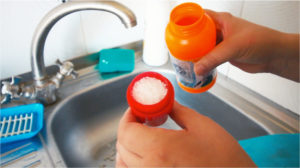 “Mole” copes well with odors and dirt, acts quickly and effectively, and is sold at an affordable price. His the liquid variety is less aggressive than the granules, and does not damage the plastic.
“Mole” copes well with odors and dirt, acts quickly and effectively, and is sold at an affordable price. His the liquid variety is less aggressive than the granules, and does not damage the plastic.- “Tiret” cleans pipes of any type, restores drainage in a short time (5-30 minutes, time determined by complexity). Thanks to the safe properties of the gel, you don’t have to wash off the composition until the morning.
- "Domestos". Its composition allows you to easily solve the main problem. In addition, the gel base protects the drain from the inside, forming a protective film. The created layer provides disinfection and blocks the settling of waste on the walls for some time.
- “Bagi Pothan” is a powdery substance that can give the best results. The mixture is poured into the sink hole and hot water is added. The process itself takes about 3 minutes. Its disadvantage is its high cost. When using, eye, skin, and respiratory protection is required.
Attention! We carry out all actions wearing gloves and respirators, ensuring a flow of fresh air into the room.
Important! Before working with these preparations, drain the accumulated water from the sink. To ensure quality processing, follow the instructions on the label.
Folk ways
There are proven, easy and affordable methods that our grandmothers used.
Important! Plastic structures are washed only with hot water. It is allowed to pour boiling water if the pipes are made of steel.
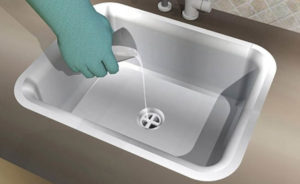 Take 100 g of salt and sprinkle it on the drainage hole.Immediately fill with heated liquid, wait several hours, and then flush the drain with hot pressure.
Take 100 g of salt and sprinkle it on the drainage hole.Immediately fill with heated liquid, wait several hours, and then flush the drain with hot pressure.- The following procedure is best performed in the evening. Mix salt and soda in equal proportions and fill the hole in the sink with the mixture. Pour boiled water over it and leave it until the morning.
- Using citric acid it will be possible not only to clean the plumbing from dirt, but also to scent the room. Pour one sachet of the substance into the drain, add boiling water, and after 30 minutes wash off the mixture with warm pressure.
- You can solve the problem with soda, at the rate of 250 g per 100 ml of vinegar. Heat the vinegar a little in a water bath. Pour soda into the drain and fill it with the heated component. For this method to work, plug the hole with a damp rag.. We wait 30 minutes, pour boiling water into the sink and start a stream of warm liquid.
On a note! In the latter method, instead of regular soda, it is convenient to use a calcined analogue. Its consumption is 2 times less, it has stronger properties in the fight against blockages.
Prevention
Take measures that will save you from unnecessary problems and extend the life of your plumbing fixtures:
- If you are leaving home for a long time, add a little vegetable (or machine) oil to the sink drain before leaving. The product forms a thin layer on the surface of the water that will prevent evaporation.
- Every time after washing dishes, rinse the drain opening with a stream of hot water.
- Equip the sink with a protective mesh; it will trap food debris.
- Once a month, treat the sink with chemicals or traditional methods.
Most of the problems that cause bad odors in the kitchen can be eliminated by the owner on his own.It is important to correctly determine the cause and then correct the defect using the most accessible and appropriate method. If you encounter any difficulties, contact a plumbing service.




